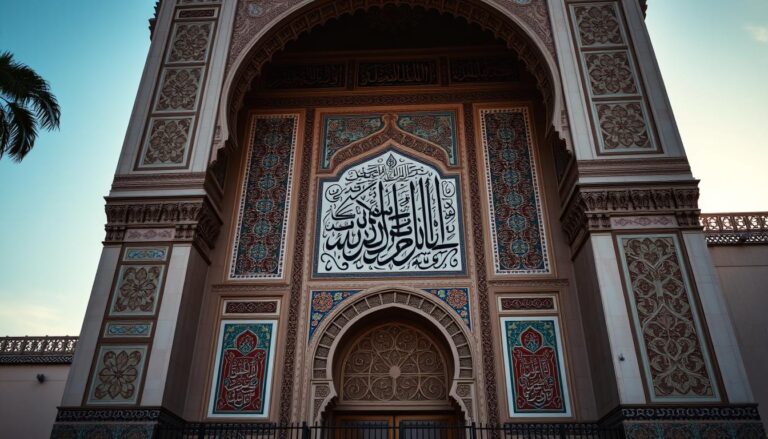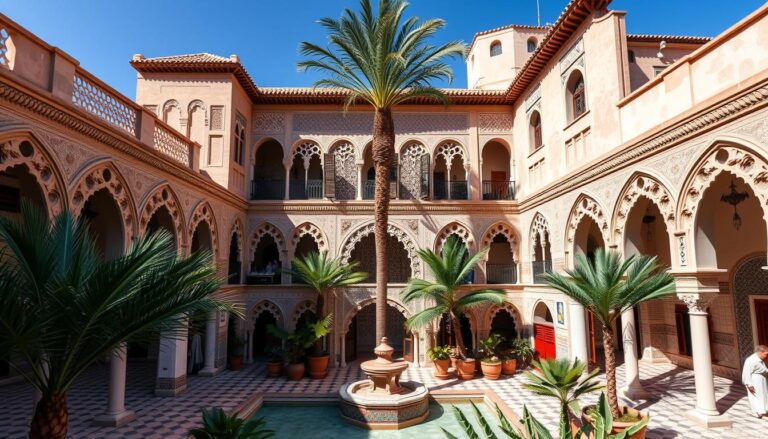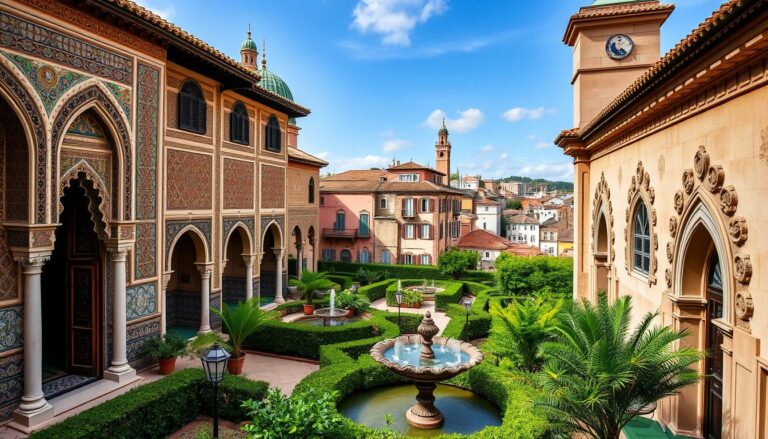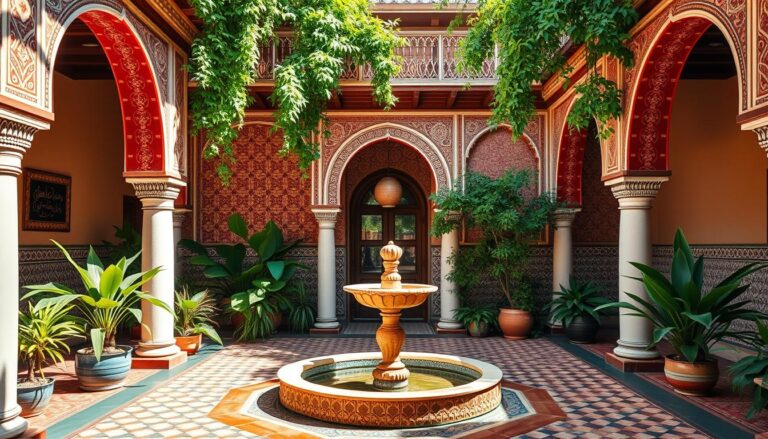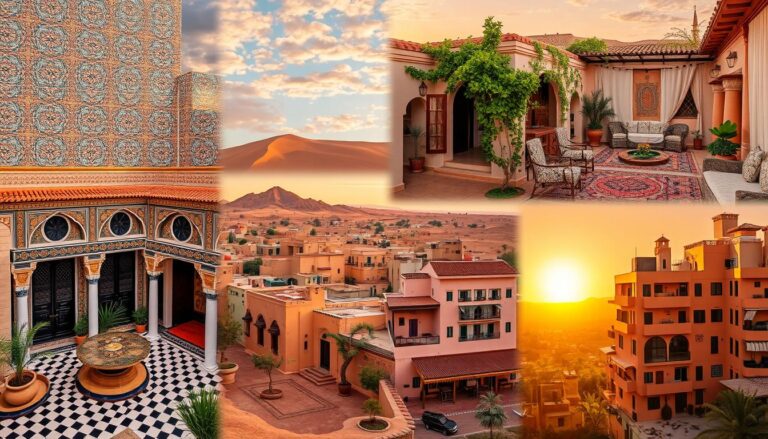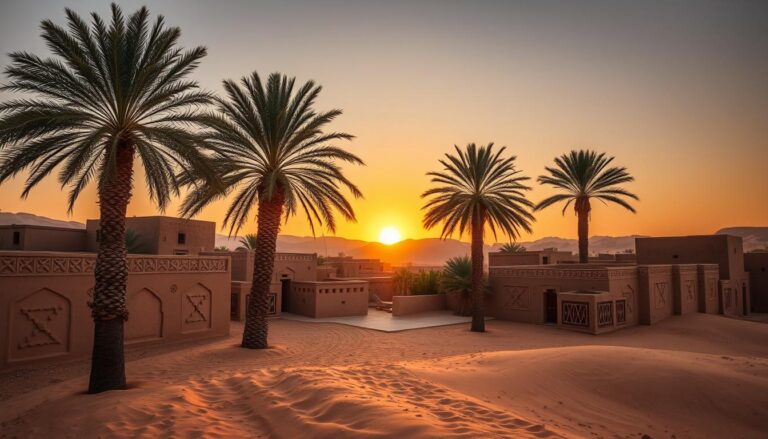Ever wondered about the history of Moroccan courtyards, or “riads”? These architectural wonders reveal the rich culture and design principles of traditional Moroccan homes. They’ve been a part of Moroccan life for centuries.
The word “riad” means “gardens” in Arabic. It refers to the interior gardens found in historic Moorish buildings in Al-Andalus (Iberian Peninsula) and North Africa. These courtyards are shaped like rectangles, divided into four parts by a central axis. They often have a fountain in the middle.
The idea of riad gardens started in the Persian world. Important examples can be seen in places like Madinat al-Zahra, the Aljaferia, and the Alhambra. The close ties between al-Andalus and North Africa led to a shared architectural and artistic heritage.
Key Takeaways
- The term “riad” comes from the Arabic word for “gardens” (riyād), referring to a type of interior courtyard garden common to historic Moorish architecture.
- Moroccan courtyard homes, or riads, are symmetrically designed with a central fountain and lush greenery, reflecting a close connection to nature.
- The origins of riad gardens can be traced back to the eastern Persian world, with influential examples found in the Iberian Peninsula’s al-Andalus region.
- There was a close cultural and geopolitical relationship between al-Andalus and North Africa, leading to a shared architectural and artistic heritage.
- Moroccan courtyards were designed to maximize family privacy and promote natural ventilation, showcasing the region’s sustainable design principles.
The Origins of Riad Architecture
Moroccan riads are inspired by ancient Roman villas and Persian gardens. Roman villas had enclosed courtyards for privacy and peace. Riads also have these features. The Mesopotamian influence brought the idea of Persian gardens, seen as a paradise on Earth.
This mix of Roman practicality and Persian beauty is a key part of architectural history. Each riad is a story of East meeting West.
Influence of Roman Villas and Persian Gardens
A riad is a rectangular garden with four quadrants and two paths meeting in the middle. It often has a fountain. This design is similar to ancient Roman villas.
The Persian gardens of the Middle East also shaped Moroccan riads. They focus on calm water and greenery.
“Riads offer an authentic experience with easy access to notable sights and monuments due to their central location in the heart of the medina.”
The architectural heritage of al-Andalus and North Africa, especially during the Almoravid era, connects riads to ancient traditions. From Roman villas to Persian gardens, riads’ roots are deep. They weave together cultures, still fascinating visitors today.
Islamic Flourishing and Cultural Integration
Morocco’s architecture changed a lot when Islamic rulers came in the 7th century. They introduced the riad, a beautiful architectural wonder. It showed off amazing ornamentation and detailed tilework.
The Idrisid dynasty was at the forefront of this change. They brought Islamic influence and also used elements from their Andalusian conquests. This led to a time of architectural growth.
This mix of cultures led to more artistic collaboration. Artisans from different backgrounds worked together. They created spaces that showed off a mix of cultures. The riad, with its open courtyards and fancy designs, became a symbol of this time. It mixed function with beauty.
The Andalusian architecture the Idrisids used was a mix of Islamic, Roman, and Berber styles. This cultural influence is seen in the unique horseshoe arches, detailed zellij tilework, and the focus on courtyard spaces. These became key features of Moroccan design.
“The riads, with their open courtyards and ornate designs, became symbols of this historical significance, blending functionality with art.”
The Islamic architecture of this time showed off the area’s artistic talent. It also showed the strong cultural influence that shaped the Idrisid dynasty and Moroccan design. This legacy is still celebrated and kept alive today. It’s a sign of the lasting power of cultural exchange and artistic teamwork.
Development of Moroccan Courtyards
The Moroccan riad, a traditional house with an interior courtyard, shows the growth of courtyard design. It keeps privacy and symbolizes the universe, with a fountain at its heart.
Architectural Elements and Design Principles
A Moroccan riad has a rectangular garden split into four parts by two paths. A fountain sits at the center. The garden areas are lower than the paths, creating balance.
This design follows Islamic norms, keeping family life private from outsiders. Rooms in a riad face the courtyard, not the outside. This focus on the courtyard reflects Moroccan values of family and privacy.
“The inward-facing scheme of the riad is designed to maximize family privacy from the outside world, conforming to Islamic cultural norms.”
Moroccan courtyards use nature and water to create a peaceful space. Fountains and green spaces add beauty and function to these private areas.
Moroccan courtyards blend Islamic, African, and European influences. This unique style attracts visitors and inspires designers. It shows the lasting appeal and practicality of this design.
Moroccan Craftsmanship and Artistry
Moroccan riads showcase the amazing craftsmanship and artistry passed down through generations. The smooth, colored tilework and detailed woodcarving create stunning Islamic ornamentation. This is both beautiful and culturally important.
Intricate Tilework and Woodcarving Traditions
The smooth tadelakt surfaces of Moroccan riads are a striking contrast to the complex zellij tilework. The wooden lattice moucharabieh screens are also intricately carved. Intricate stucco cornices and trim, known as gebs, connect walls and ceilings.
Support beams feature vibrant, hand-painted zouaq woodcraft. Islamic tradition forbids living figures in decorative arts. So, designs are based on geometric or floral forms, showing Moroccan design’s rich heritage.
“The craftsmanship in Moroccan woodwork includes creating bed board stands with creative features such as combining bones, various oak woods, and wet with old wood for unique aesthetics.”
This diverse tapestry of craftsmanship and artistry highlights Moroccan design’s cultural significance. It makes each riad a unique and captivating experience for visitors.
Riads as Elite Retreats
The Moroccan riad luxury has grown, turning grand homes into exclusive accommodations. These places offer privacy, comfort, and historical significance. They are now a way to dive into Morocco’s cultural heritage.
Riads’ central courtyards, once a quiet escape, now welcome the elite. Staying here is more than a vacation. It’s a chance to experience Morocco’s history, surrounded by peace.
“The riads in Marrakesh offer green oases within the city, providing tranquil spaces for guests to enjoy.”
The rise of riads, known as “riad fever,” is changing Morocco. Historic cities, now UNESCO World Heritage Sites, attract European investors. They seek exotic destinations like Morocco.
The Moroccan government helps manage heritage tourism and property. They aim to attract investors while keeping the cultural heritage safe. Projects focus on tourism and preserving the prestigious history of these exclusive accommodations.
The Royal Mansour in Marrakech is a prime example of riad luxury. It was built by over 1,000 artisans. The hotel has 53 unique riads, with the smallest being 1,500 square feet and the largest, the Grand Riad, at 19,375 square feet.
Royal Mansour boasts many amenities. Guests can enjoy four restaurants, a massive 27,000 square feet spa, and wellness programs. The Prestige Riad’s nightly rate starts at $6,840, making it a top choice for luxury seekers.
The Best Riads in Morocco
Morocco’s riads are top-notch places to dive into the country’s culture. You’ll find them in Marrakech and Fes. These traditional homes show off Morocco’s amazing architecture.
Marrakech Riads: Oases of Tranquility
Marrakech is famous for its riads. They are known for their detailed design and luxury. Inside, you’ll find calm courtyards with fountains and orange blossoms, a peaceful break from the city.
Riad Momo is a standout with a five-star rating on Airbnb. Marrakech’s riads have something for everyone, from couples to families.
Fes: The Embodiment of Moroccan Craftsmanship
Fes is known for its rich culture and riads. These homes show off Moroccan craftsmanship with tilework and woodcarvings. They have peaceful gardens, bringing Morocco’s design to life.
Riads like Riad Sadaka and Riad Goloboy are great for groups or families. They offer a private space in the lively city.
Merzouga: Luxury in the Desert
Merzouga riads are in the Saharan desert. They offer a quiet retreat with views of dunes and stars. These places mix traditional Moroccan style with modern comforts.
Merzouga’s riads have private pools and big terraces. They provide a unique experience, blending old and new.
“Staying in a riad in Morocco is a truly immersive cultural experience, allowing travelers to connect with the country’s rich heritage and architectural wonders.”
Conclusion
Moroccan courtyards, known as riads, have a long and rich history. They go back to ancient times, influenced by Roman villas and Persian gardens. Under Islamic rule, they evolved into symbols of Moroccan culture and identity.
Today, riads are luxury retreats for the elite. They offer privacy, comfort, and a deep connection to Morocco’s past. You can find them in Marrakech, Fes, and Merzouga, each with its own charm.
The design of Moroccan courtyards shows the lasting impact of Moroccan architecture. They adapt to different climates and blend social and cultural aspects. This makes them a model for sustainable and culturally-aware housing worldwide.
In short, Moroccan courtyards, especially riads, tell a story of preserving culture and architectural innovation. These spaces showcase Morocco’s rich heritage and the beauty of its built environment.
Source Links
- The Art Of The Moroccan Riad – Metropolis
- From Islamic to Art Deco: A rich history of Moroccan architecture
- The Timeless Design of Moroccan Homes
- Riad (architecture)
- Discovering the Enchanting World of Riads: Moroccan Tranquility Unveiled
- The Art of the Riad — Maana Travel
- Moroccan architecture
- Cultural Heritage of Zellij in Moroccan Architecture | Paris Tile
- Moorish architecture
- Moroccan Architecture: In-Depth Review of Styles in Morocco
- The Traditional Architecture of the Moroccan House
- Moroccan Artisans | ECODNA.ART – Sustainability and Art Blog
- How Fez Is Keeping Traditional Architecture and Craftsmanship Alive
- Find Your Moroccan Oasis in Marrakesh
- Moroccan Magic: Inside the Royal Mansour Marrakech
- The prettiest riads in Marrakech
- 15 STUNNING Riads in Marrakech [2024 Edition]
- The prettiest riads in Marrakech
- Environmental and socio-cultural transition from traditional courtyard dwellings to contemporary housing practices in Morocco: insights from Arab and East Asian regions – Journal of Umm Al-Qura University for Engineering and Architecture
- Parametric Modelling and Traditional Architecture: Improving the thermal comfort of the traditional courtyard house in Morocco

The Editorial Team is a passionate group of Morocco enthusiasts dedicated to sharing the beauty, culture, and wonders of this captivating country. With diverse backgrounds and a deep love for travel, we strive to bring you engaging and informative content that inspires your Moroccan adventures. From uncovering hidden gems and sharing local insights to exploring mouthwatering cuisine and showcasing the vibrant lifestyle, our team is committed to providing you with valuable resources and exciting stories that enhance your exploration of Morocco. Join us on this journey as we celebrate the rich heritage and unforgettable experiences that make Morocco truly special.


